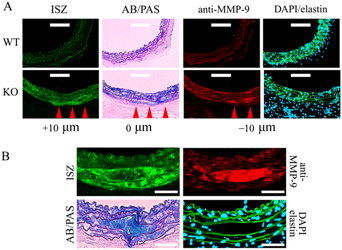 |
January 2007 Mouse of the Month |
|
RECS1 knockout mouse A key molecule for vascular remodeling
BRC No. 01773_ RECS1 knockout mouse line26
|
|
 |
Figure (A)Spatial pattern analysis of gelatinolytic activity, cystic medial degeneration (CMD) and MMP-9 protein levels in throracic aortas from old RECS1 KO mice. Arrowheads indicate large CMD foci. (B)A representative large CMD focus in KO mouse. Scale bar=100μm. ISZ: In situ zymography AB/PAS: Alician Blue/Periodic Acid Schiff. In detail, please see Circulation Journal. 2006; 70 (5): 615-624. |
RECS1 is one of the mechanical stress responsive genes and functions as a negative regulator of matrix metalloprotease 9 (MMP-9). RECS1 deficient mice are prone to aortic dilation and cystic medial degeneration (CMD) when the mice ages (older than 14 months). Aortic dilation and CMD are frequently encountered pathological findings in aortic aneurysms as well as in normal aging aorta. This strain is useful for study of the function of RECS1 gene and as a mouse model for aortic dilation and CMD.




